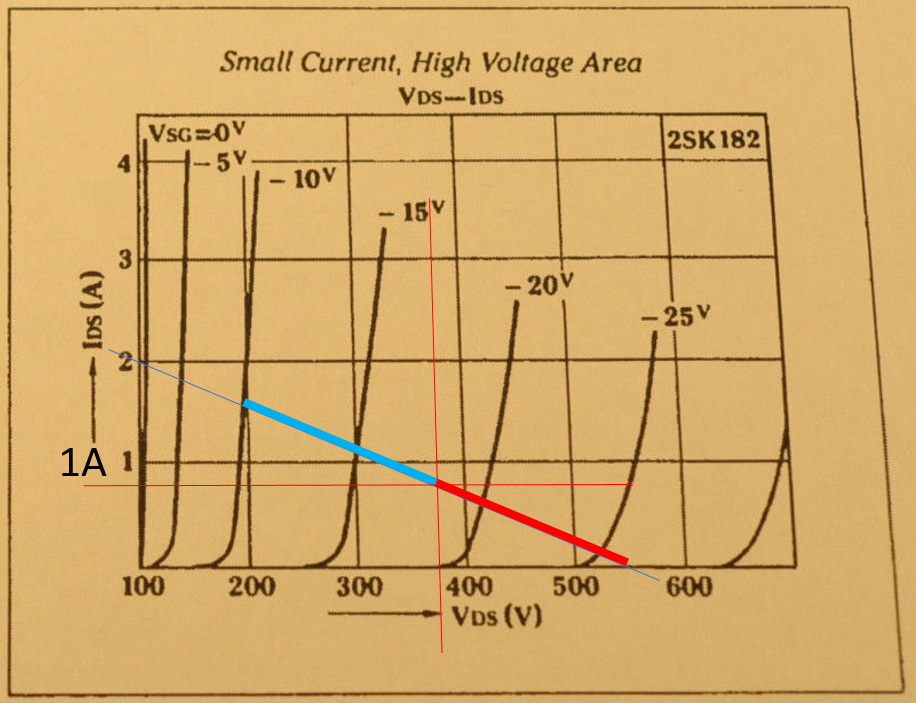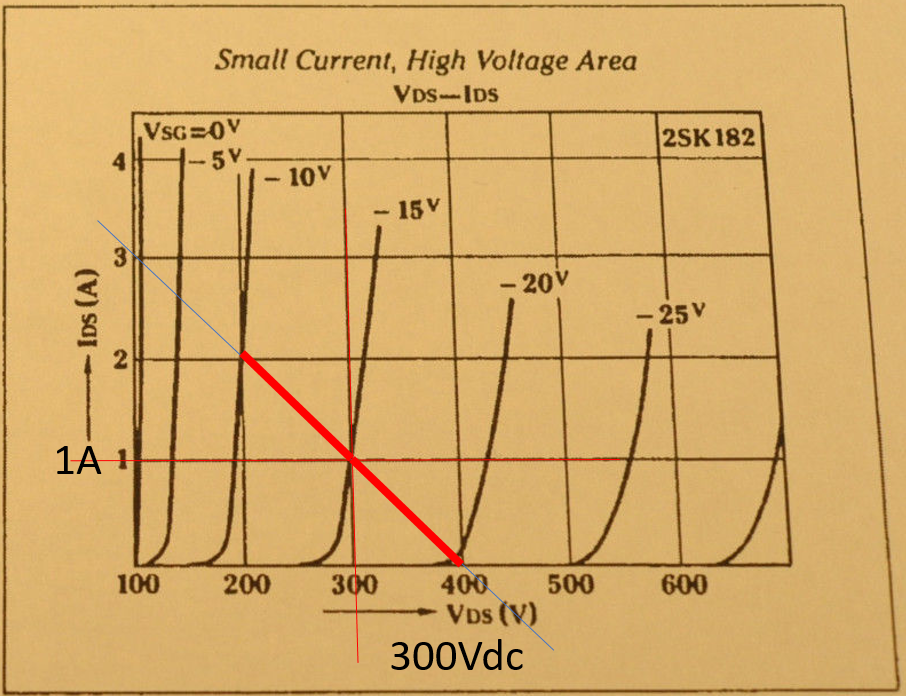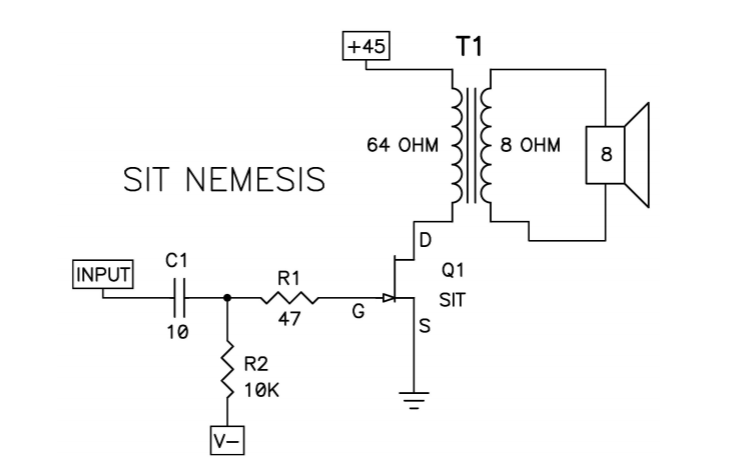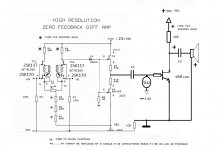Hi guys,
Has anyone tried high voltage low current with THF-51S or 2SK182? Say 300Vds 1A Ids (300Pd)? Will such operating point actually works?
Was thinking of the line of using an output transformer as load, with say 250 Ohm primary impedance.
Cheers!
Jo
Has anyone tried high voltage low current with THF-51S or 2SK182? Say 300Vds 1A Ids (300Pd)? Will such operating point actually works?
Was thinking of the line of using an output transformer as load, with say 250 Ohm primary impedance.
Cheers!
Jo
....300Vds 1A Ids....
Psu filter capacitors rated at + 300V cost big money.
80~100V DC is more realistic imho. Best regards 🙂
Thanks Soundhappy! 
I was thinking of using bigger chokes with smaller caps to get over the ripple issue, or even CLCLC. This will overcome the caps cost issue. 🙂

I was thinking of using bigger chokes with smaller caps to get over the ripple issue, or even CLCLC. This will overcome the caps cost issue. 🙂
Psu filter capacitors rated at + 300V cost big money.
80~100V DC is more realistic imho. Best regards 🙂
Hi Maxlorenz,
What sort of power regulator do you recommend?
I've considered SMPS from Connexelectroncs. Their custom voltage versions will be able to provide single high voltage rail.
High voltage low current will be appreciated by OPTs (it is easier to design high voltage low current than high current low voltage OPTs).
What do you think of such bias proposals below?


Rgds,
Jo
What sort of power regulator do you recommend?
I've considered SMPS from Connexelectroncs. Their custom voltage versions will be able to provide single high voltage rail.
High voltage low current will be appreciated by OPTs (it is easier to design high voltage low current than high current low voltage OPTs).
What do you think of such bias proposals below?


Also consider high voltage SMPS single voltage plus power regulator. 😉
Rgds,
Jo
I always use the PowerReg, from teddy Pardo.
Introducing the PowerReg | pink fish media
Sorry, I cannot comment about you high voltage choice. Ask Mr. Pass...
Good luck.
M.
Introducing the PowerReg | pink fish media
Sorry, I cannot comment about you high voltage choice. Ask Mr. Pass...
Good luck.
M.
The PowerReg does look interesting.
I was thinking of having 2 power transformers, 1 for the B+ (un-regulated, raw), another for the bias. The B+ transformer will have a small delay, implemented by soft-start module, to avoid bias coming up slower than the B+.
Thanks anyway for the suggestion. I will look more into this PowerReg as it can be used for other projects too.
Now back to my storeroom/lab for more experiments on the high voltage IV curves for the SIT I got. I'm used to working on high voltage amplification with tube circuits but not SITs.
I was thinking of having 2 power transformers, 1 for the B+ (un-regulated, raw), another for the bias. The B+ transformer will have a small delay, implemented by soft-start module, to avoid bias coming up slower than the B+.
Thanks anyway for the suggestion. I will look more into this PowerReg as it can be used for other projects too.
Now back to my storeroom/lab for more experiments on the high voltage IV curves for the SIT I got. I'm used to working on high voltage amplification with tube circuits but not SITs.
I always use the PowerReg, from teddy Pardo.
Introducing the PowerReg | pink fish media
Sorry, I cannot comment about you high voltage choice. Ask Mr. Pass...
Good luck.
M.
I'm used to working on high voltage amplification with tube circuits but not SITs.
Do You read all Mr. Pass articles about SIT's and Vfet's ?
http://www.firstwatt.com/pdf/art_sit_nemesis.pdf
http://www.firstwatt.com/pdf/art_sony_vfet_pt1.pdf
....and more FIRST WATT ARTICLES
It's depletion mode transistor You need take care.
Greetings 🙂
Hi Soundhappy,
Thank you for the advices/inputs.
Yes, reading in progress. I'm reading through this thread too to capture as much learnings on the SIT as I can.
What I have in mind is something what you've pointed in the links you sent - as follow:

I think I'll need to be very careful on the biasing part since these device can draw quite a lot of current, as compared to tubes like 300B, 211 or 845. Such current may burn the OPTs if not careful.
I could not find detailed high voltage curves, unlike tubes where the IV curves are usually published, and is within 10-20% tolerances.
Cheers!
Thank you for the advices/inputs.
Yes, reading in progress. I'm reading through this thread too to capture as much learnings on the SIT as I can.
What I have in mind is something what you've pointed in the links you sent - as follow:

I think I'll need to be very careful on the biasing part since these device can draw quite a lot of current, as compared to tubes like 300B, 211 or 845. Such current may burn the OPTs if not careful.
I could not find detailed high voltage curves, unlike tubes where the IV curves are usually published, and is within 10-20% tolerances.
Cheers!
Do You read all Mr. Pass articles about SIT's and Vfet's ?
http://www.firstwatt.com/pdf/art_sit_nemesis.pdf
http://www.firstwatt.com/pdf/art_sony_vfet_pt1.pdf
....and more FIRST WATT ARTICLES
It's depletion mode transistor You need take care.
Greetings 🙂
The PowerReg does look interesting.
I was thinking of having 2 power transformers, 1 for the B+ (un-regulated, raw), another for the bias. The B+ transformer will have a small delay, implemented by soft-start module, to avoid bias coming up slower than the B+.
The PowerReg (maybe all power regulators) make the voltage climb slowly, so it is sort of a soft start. You will need good quality, high voltage, low leakage capacitors (and high voltage transistors) if you decide to use it. Of course, the negative V bias circuit will be there first if you use a conventional voltage regulator.
The regulated power has the added advantage of reducing the capacitance required for a linear PS.
 😎
😎I attach an App. Note that deals with high voltage regulation.
Good luck and have fun.
M.
Attachments
I could not find detailed high voltage curves, unlike tubes
where the IV curves are usually published, and is within 10-20% tolerances.
Cheers!
Try excellent AudioMaker.tech ! 🙂
Bunch of informations and softwares for SIT's
: simulation and curve tracer can be useful to test this real transistors on Your work bench
Load Line Tutorial L'Amp 2SK180
Frankentracer part 1
Frankentracer part 2
Apps & Files | AudioMaker
Thanks Max!
That definitely helps. I've been thinking on what to do with the power up sequence, and the slow start from PowerReg definitely is interesting. I'm just a bit concerned on regulator on power amps - will it limit the dynamics? Based on my listening experience, I prefer unregulated PSU for power amps. It sounds more relaxed - just my 2 cents.
That definitely helps. I've been thinking on what to do with the power up sequence, and the slow start from PowerReg definitely is interesting. I'm just a bit concerned on regulator on power amps - will it limit the dynamics? Based on my listening experience, I prefer unregulated PSU for power amps. It sounds more relaxed - just my 2 cents.
The PowerReg (maybe all power regulators) make the voltage climb slowly, so it is sort of a soft start. You will need good quality, high voltage, low leakage capacitors (and high voltage transistors) if you decide to use it. Of course, the negative V bias circuit will be there first if you use a conventional voltage regulator.
The regulated power has the added advantage of reducing the capacitance required for a linear PS.😎
I attach an App. Note that deals with high voltage regulation.
Good luck and have fun.
M.
Yes, I had this concern too: sometimes I feel the regulator might taint the sound but a well executed VFET amp will erase your concerns in two seconds, probably, plus the bass is great.
The PowerReg, with film caps, ends up being BIG.
My own preference is for a resistor loaded VFET amp (the R protects the VFET, as MR explained before) with a "low thermal memory" input section, like the one I posted before. This really opens up the sound and increases dynamics and transparency.
(I use slightly different local feedback resistor values now)
Good luck.
M.
PS: apparently the 2SK30 JFET has low thermal memory effect, as shown by Hephaïstos, so I will check this with a simple differential pair soon!
The PowerReg, with film caps, ends up being BIG.
My own preference is for a resistor loaded VFET amp (the R protects the VFET, as MR explained before) with a "low thermal memory" input section, like the one I posted before. This really opens up the sound and increases dynamics and transparency.
(I use slightly different local feedback resistor values now)
Good luck.
M.
PS: apparently the 2SK30 JFET has low thermal memory effect, as shown by Hephaïstos, so I will check this with a simple differential pair soon!
Attachments
Last edited:
Ya, high voltage high current PSU are huge. 
At the end, I'm probably gonna use a tube driver stage, but for initial phase, anything simple to hook-up will do. Thanks for the schematic and links! I've read Mike's stuff over and over again, hoping not to smoke my limited THF-51s.
Enjoy the 2SK130!

At the end, I'm probably gonna use a tube driver stage, but for initial phase, anything simple to hook-up will do. Thanks for the schematic and links! I've read Mike's stuff over and over again, hoping not to smoke my limited THF-51s.
Enjoy the 2SK130!
Yes, I had this concern too: sometimes I feel the regulator might taint the sound but a well executed VFET amp will erase your concerns in two seconds, probably, plus the bass is great.
The PowerReg, with film caps, ends up being BIG.
My own preference is for a resistor loaded VFET amp (the R protects the VFET, as MR explained before) with a "low thermal memory" input section, like the one I posted before. This really opens up the sound and increases dynamics and transparency.
(I use slightly different local feedback resistor values now)
Good luck.
M.
PS: apparently the 2SK30 JFET has low thermal memory effect, as shown by Hephaïstos, so I will check this with a simple differential pair soon!
I am already listening to the 2SK30A GR input. Sounds nice. Probably "rounder" than the 2SK170, though transconductance is much lower than the later.
Anyway, the cascoded-CFP input ("Low TMD") sounds better than both, IMHO, more dynamically contrasted, more transparent and with a certain "magic" to it.
Cheers,
M.
Anyway, the cascoded-CFP input ("Low TMD") sounds better than both, IMHO, more dynamically contrasted, more transparent and with a certain "magic" to it.
Cheers,
M.
I just wonder, if 2SK180 and such SITs can be used in source follower configuration, like MOFO? Anyone tried that?
I wouldn't recommend the MoFo circuit for a SIT. Some other follower, perhaps. But If I had some 2SK180's lying around, I use them in a CS amp. 🙂
- Home
- Amplifiers
- Pass Labs
- L'Amp: A simple SIT Amp

